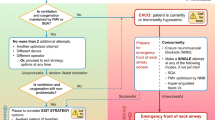Abstract
Objective
To evaluate the efficacy of a simple mechanical device to maintain constant endotracheal cuff pressure (Pcuff) during mechanical ventilation (large encased inflatable cuff connected to the endotracheal cuff and receiving constant pressure from a heavy mass attached to an articulated arm).
Design and setting
Single-center, prospective, randomized, crossover, pilot study in a medical intensive care unit.
Patients and participants
Nine consecutive mechanically ventilated patients (age 62 ± 20 years, SAPS II score 39 ± 15).
Interventions
Control day: Pcuff monitored and adjusted with a manometer (Hi-Lo™, Tyco Healthcare) according to current recommendations (twice a day and after each intervention on the tracheal tube); initial target Pcuff 22–28 cmH20. Prototype day: test device connected to the endotracheal cuff; same initial target. Continuous Pcuff recording during both days. Control and prototype days in random order.
Results
Pcuff values over 50 cmH20 were recorded in six patients during the control day (178 ± 159 min), never during the prototype day. During the control day, Pcuff was between 30 and 50 cmH20 for 29 ± 25% of the time, vs 0.3 ± 0.3% during the prototype day (p < 0.01). Pcuff was between 15 and 30 cmH20 for 56 ± 36% of the time during the control day, vs 95 ± 14% during the prototype day (p < 0.01). During the control day, Pcuff was below 15 cmH20 for 15 ± 17% of the time, vs 4.7 ± 15% during the prototype day (p < 0.05).
Conclusions
The tested device successfully controlled Pcuff with minimal human resource consumption. Prospective studies are required to assess its clinical impact.



Similar content being viewed by others
References
Sue RD, Susanto I (2003) Long-term complications of artificial airways. Clin Chest Med 24:457–471
Vyas D, Inweregbu K, Pittard A (2002) Measurement of tracheal tube cuff pressure in critical care. Anaesthesia 57:275–277
Société de Réanimation de Langue Française (1998) XVIIIe conférence de consensus en réanimation , “Quel abord trachéal pour la ventilation mécanique des malades de réanimation?”, available online at http://www.sfar.org/srlfsfar/abordtrachccons.html. Accessed 5 July 2006
Klainer AS, Turndorf H, Wu WH, Maewal H, Allender P (1975) Surface alterations due to endotracheal intubation. Am J Med 58:674–683
Deslee G, Brichet A, Lebuffe G, Copin MC, Ramon P, Marquette CH (2000) Obstructive fibrinous tracheal pseudomembrane. A potentially fatal complication of tracheal intubation. Am J Respir Crit Care Med 162:1169–1171
Grillo HC, Cooper JD, Geffin B, Pontoppidan H (1971) A low-pressure cuff for tracheostomy tubes to minimize tracheal injury. A comparative clinical trial. J Thorac Cardiovasc Surg 62:898–907
Fernandez R, Blanch L, Mancebo J, Bonsoms N, Artigas A (1990) Endotracheal tube cuff pressure assessment: pitfalls of finger estimation and need for objective measurement. Crit Care Med 18:1423–1426
Diaz E, Rodriguez AH, Rello J (2005) Ventilator-associated pneumonia: issues related to the artificial airway. Respir Care 50:900–906
Morris JV, Latto IP (1985) An electropneumatic instrument for measuring and controlling the pressures in the cuffs of tracheal tubes: ‘the Cardiff Cuff Controller’. J Med Eng Technol 9:229–230
Resnikoff E, Katz JA (1990) A modified epidural syringe as an endotracheal tube cuff pressure-controlling device. Anesth Analg 70:208–211
Abdelatti MO (1999) A cuff pressure controller for tracheal tubes and laryngeal mask airways. Anaesthesia 54:981–986
Farre R, Rotger M, Ferre M, Torres A, Navajas D (2002) Automatic regulation of the cuff pressure in endotracheally-intubated patients. Eur Respir J 20:1010–1013
Acknowledgements
The authors gratefully thank the intensive care unit nursing staff for their unfailing cooperation and patience. They thank Mr. Edouard Leveque, inventor of the Nosten® device, for his help, and Pr. Jean-Philippe Derenne and Nunzio Crimi for their precious input. They also thank Mrs. Marilyn Amouyal-Jones for her help with English style and grammar. Funding: Association pour le Développement et l'Organisation de la Recherche en Pneumologie (ADOREP), Paris, France.
Author information
Authors and Affiliations
Corresponding author
Rights and permissions
About this article
Cite this article
Duguet, A., D’Amico, L., Biondi, G. et al. Control of tracheal cuff pressure: a pilot study using a pneumatic device. Intensive Care Med 33, 128–132 (2007). https://doi.org/10.1007/s00134-006-0417-x
Received:
Accepted:
Published:
Issue Date:
DOI: https://doi.org/10.1007/s00134-006-0417-x




